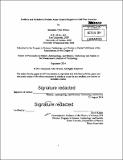Insiders and outsiders : nuclear arms control experts in Cold War America
Author(s)
Wilson, Benjamin Tyler
DownloadFull printable version (30.62Mb)
Alternative title
Nuclear arms control experts in Cold War America
Other Contributors
Massachusetts Institute of Technology. Program in Science, Technology and Society.
Advisor
David Kaiser.
Terms of use
Metadata
Show full item recordAbstract
This dissertation presents a history of the community of nuclear arms control experts in the United States during the middle and later years of the Cold War, the age of thermonuclear ballistic missiles. Arms control experts were, in many interesting ways, both insiders and outsiders to the American "nuclear state." The dissertation begins by exploring the formation of strategic arms control in the years leading up to 1960, showing how arms control emerged from the mixing of local communities of disarmament advocates and theorists of nuclear deterrence. Rather than inevitable doctrinal unity, early arms control was highly local and contingent. In particular, the crucial concept of "stability" was open to multiple interpretations. In the 1960s, arms control problems motivated groundbreaking scientific research. Elite contract consultants to the government contemplated the use of lasers as weapons against ballistic missiles. As consultants performed calculations and experiments in the context of classified discussions and studies, they founded a new field of physics called nonlinear optics. In the late 1960s, strategic arms control became a public issue during a complex political dispute over missile defense. Arms control experts mediated and fueled this controversy by participating in a surprising range of activity, rallying alongside local residents whose neighborhoods would be impacted by missile defense installations, and criticizing defense policy in Congressional testimony-even as they worked their connections to the White House. In the 1960s and 1970s arms controllers shaped a changing institutional landscape for the support of arms control expertise. They built arms control into a new government agency, and later drew on the resources of philanthropic foundations to create major university arms control centers. By the 1980s, arms control reached peak public visibility amid controversy over the Reagan administration's Strategic Defense Initiative. This dissertation uses the private papers and correspondence of numerous experts, a wide range of arms control publications, and government records to explore the diverse practices of arms control. It engages a wider discussion among historians about the status of Cold War elites, the relationship between experts and the American state, and the character of scientific knowledge during the Cold War.
Description
Thesis: Ph. D. in History, Anthropology, and Science, Technology and Society (HASTS), Massachusetts Institute of Technology, Program in Science, Technology and Society, 2014. Cataloged from PDF version of thesis. Includes bibliographical references (pages 462-499).
Date issued
2014Department
Massachusetts Institute of Technology. Program in Science, Technology and SocietyPublisher
Massachusetts Institute of Technology
Keywords
Program in Science, Technology and Society.